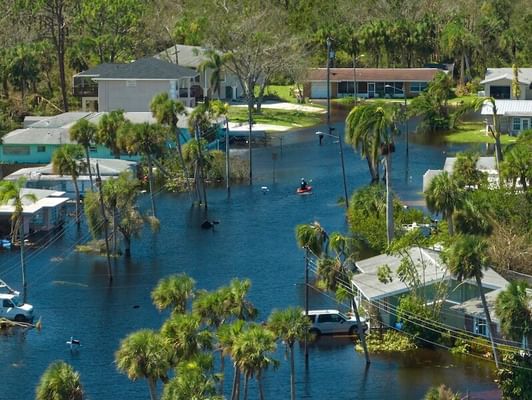- Undergraduate
Bachelor's Degrees
Bachelor of ArtsBachelor of EngineeringDual-Degree ProgramUndergraduate AdmissionsUndergraduate Experience
- Graduate
Graduate Experience
- Research
- Entrepreneurship
- Community
- About
-
Search
All Thayer News

Study Identifies Simple Rules to Help Federal Climate Funding Benefit Those Most at Risk
Jan 08, 2025 | by Catha Mayor
Current methods of prioritizing US federal funds to reduce climate risks in local communities may leave out households most in need. A Dartmouth Engineering-led study published yesterday in Proceedings of the National Academy of Sciences (PNAS) provides a framework to identify simple rules that can increase public funders' economic efficiency in achieving a range of intended policy outcomes.

Flooding from Hurricane Ian in Florida. (Photo by Bilanol)
"New and untested programs may not improve outcomes on the ground even if they're designed with good intentions," said Adam Pollack, Dartmouth Engineering research scientist and first author on the study. "We found that a one-size-fits-all approach to prioritizing funds in certain communities can fall short of federal and local objectives because of the way things like flood risk can vary substantially across neighboring households."
The study team analyzed the government's Justice40 Initiative, which requires a total of 518 federal programs to direct at least 40% of project benefits to "Justice40" communities. They evaluated this approach and many other funding rules for how well they achieve the Initiative's intended outcomes while managing potential economic tradeoffs. They then identified simple rules that can better meet intended policy outcomes than the current federal approach.
"Our framework enables funders to identify rules that best meet their management objectives," continued Pollack. "Environmental risks often vary at fine scales. For example, building-level precision can matter for detailed flood damage estimation. That precision is the difference between not flooding at all and up to three feet of flooding, which can completely destroy some houses. However, the current federal approach looks at risk and vulnerability across census tracts, which combine thousands of residents."
The researchers focused on the decision problem of allocating funds from a Justice40-covered program for elevating houses to reduce flood risk. By focusing on a household-level intervention like building elevation, the researchers were able to evaluate how mismatch between prioritization at the census tract level and interventions at the household level potentially compromises policy goals. In their case study, they found that simple rules based on household metrics perform best at meeting the Justice40's intended outcomes and economic efficiency goals, regardless of the considered budget.
"There are better ways to prioritize funds within communities and they don't have to be as complicated as the current federal approach," added Klaus Keller, Hodgson Distinguished Professor of Engineering and senior author on the study. "Part of the tension is that the current federal approach combines the problem of prioritizing grant applications across the country with the funding rule local decision-makers must follow. The federal government can still produce guidance and standards for screening tools and approaches for local spending, but approaches that accommodate local decision-makers' knowledge about residents in need may help policies better achieve intended outcomes."
Pollack hopes their findings will inspire decision-makers to design and test rules that cost-effectively target the most at-risk households, and accrue large net benefits such as better allocating limited resources and lining up public investment with declared objectives. The work offers strategies for agencies to refine their implementation of environmental policy while aligning with the federal government's commitment to "consistent and systematic fair, just and impartial treatment of all individuals."
As for next steps, "There are key information needs that follow from the policy implications of our results," said Pollack. "And there are opportunities for researchers and decision-makers to collaborate to fill these needs in a way that produces real benefits and helps advance science."
For contacts and other media information visit our Media Resources page.
